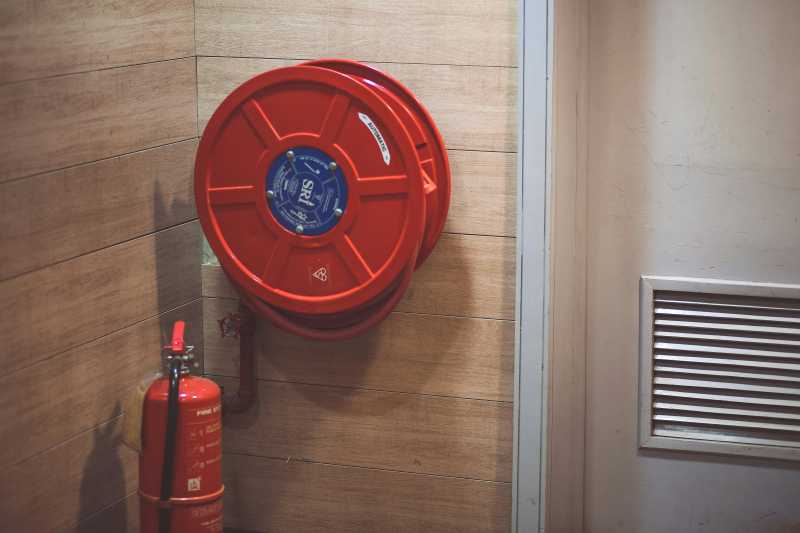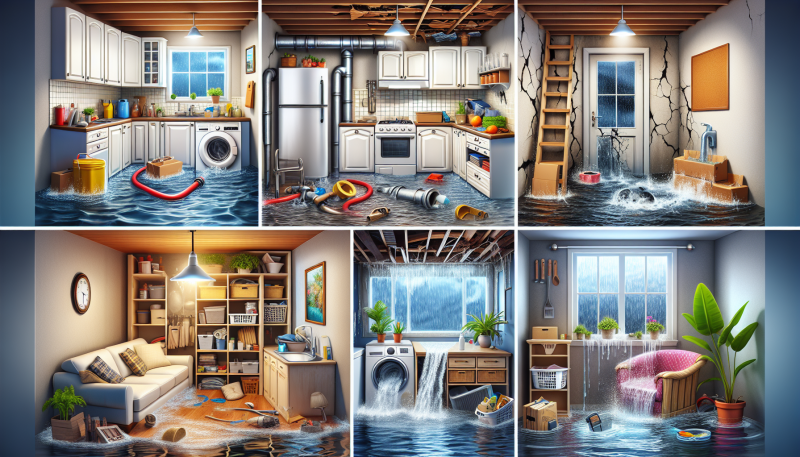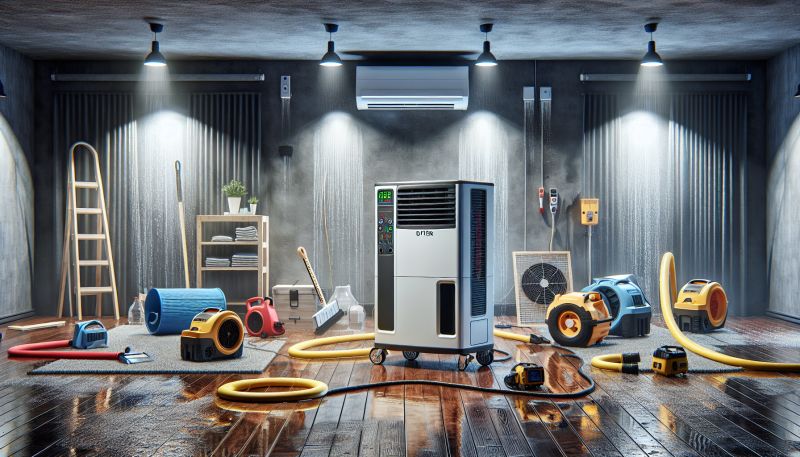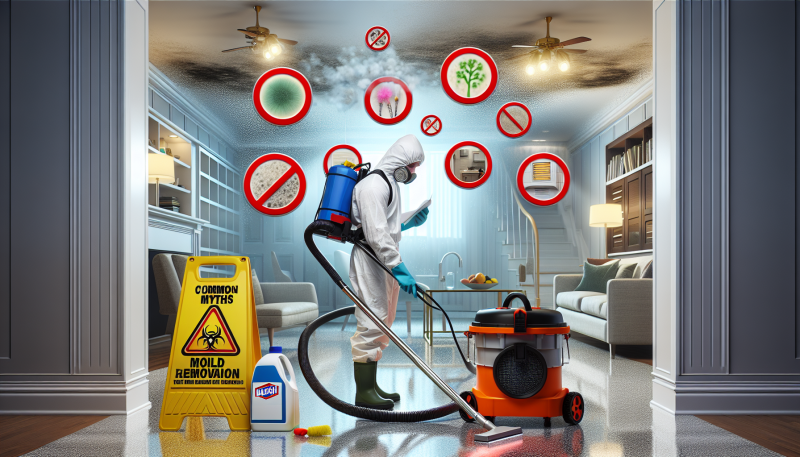Mold is more than just an unsightly nuisance in your home; it poses significant health risks that can affect you and your loved ones. Untreated mold can lead to a variety of health issues, including respiratory problems, allergies, and even more severe conditions for those with compromised immune systems. Understanding the dangers associated with mold growth is essential for maintaining a safe and healthy living environment. If you’ve experienced water damage, it’s crucial to act quickly, as mold thrives in damp conditions. At our company, we are committed to quality service, offering fast, friendly, and professional assistance to help you tackle mold issues effectively. Our specialized water damage restoration services utilize advanced equipment designed for drying structures and preventing mold growth. Don’t wait until it’s too late—schedule your consultation today by calling us at 855-933-7935. Protect your home and health by addressing mold problems promptly!
Understanding Mold: What You Need to Know
Mold is a type of fungus that thrives in damp, warm environments and can be found both indoors and outdoors. Understanding mold is crucial for maintaining a healthy living space, especially when considering the health risks associated with untreated mold. Mold spores are microscopic and can easily become airborne, leading to widespread contamination in homes and buildings. When mold is present, it can produce allergens, irritants, and potentially toxic substances known as mycotoxins. Exposure to these elements can lead to a variety of health issues, particularly for individuals with pre-existing respiratory conditions, allergies, or weakened immune systems.
The growth of mold is often linked to moisture problems, which can arise from various sources such as water damage, leaks, high humidity, or poor ventilation. It is essential to address any water intrusion promptly to prevent mold growth. According to the Environmental Protection Agency (EPA), mold can begin to grow within 24 to 48 hours after water exposure, making swift action critical.
Health risks associated with mold exposure can vary widely among individuals. Common symptoms include nasal congestion, coughing, wheezing, skin irritation, and eye irritation. More severe reactions can occur in sensitive individuals, leading to asthma attacks or other respiratory issues. The Centers for Disease Control and Prevention (CDC) emphasizes that people with asthma, allergies, or compromised immune systems are at a higher risk of experiencing adverse health effects from mold exposure.
In addition to respiratory issues, mold exposure has been linked to other health problems. Some studies suggest a connection between mold exposure and neurological symptoms, although more research is needed to fully understand these effects. The World Health Organization (WHO) has also recognized the potential for mold to contribute to mental health issues, highlighting the importance of maintaining a mold-free environment for overall well-being.
To effectively manage mold, it is vital to identify and eliminate the source of moisture. This may involve repairing leaks, improving ventilation, and using dehumidifiers in areas prone to dampness. Once the moisture issue is resolved, any existing mold should be removed. It is advisable to consult professionals for mold remediation, especially in cases of extensive contamination. DIY mold removal can sometimes exacerbate the problem if not done correctly, potentially releasing more spores into the air.
Preventing mold growth is an ongoing process that requires vigilance. Regular inspections of areas prone to moisture, such as basements, bathrooms, and kitchens, can help catch mold issues early. Homeowners should also be aware of the signs of mold growth, which can include a musty odor, visible mold patches, or water stains on walls and ceilings.
In conclusion, understanding mold and its health risks is essential for maintaining a safe and healthy living environment. By addressing moisture issues promptly and taking preventive measures, individuals can significantly reduce the likelihood of mold growth in their homes. For more information on mold remediation and prevention, consider visiting our mold remediation page, or check out our services to learn about how we can help you maintain a mold-free environment. If you have any questions, feel free to visit our FAQ section for more insights.
For further reading on the health impacts of mold, you can refer to the CDC’s guidelines on mold and health here and the EPA’s resources on mold remediation here. Remember, proactive measures and timely interventions are key to preventing the health risks associated with untreated mold.
Common Types of Mold Found Indoors
Mold is a common issue in many indoor environments, and understanding the various types can help homeowners and tenants identify potential health risks associated with untreated mold. Mold thrives in damp, humid conditions and can be found in various locations within a home, including bathrooms, kitchens, basements, and areas with water damage. Among the most prevalent types of mold found indoors are Cladosporium, Penicillium, Aspergillus, and Stachybotrys chartarum, commonly known as black mold.
Cladosporium is often found on damp materials such as carpets, wood, and fabrics. It can appear as olive-green or black spots and is known to cause respiratory issues, particularly in individuals with allergies or asthma. Penicillium is another common mold that can be found on water-damaged materials, including walls and ceilings. It is usually blue or green and can produce mycotoxins that may lead to allergic reactions and respiratory problems.
Aspergillus is a diverse genus of mold that can be found in various indoor environments, particularly in areas with poor ventilation. Some species of Aspergillus can produce harmful toxins, making it essential to address any mold growth promptly. Stachybotrys chartarum, or black mold, is notorious for its potential health risks. It typically grows on materials with high cellulose content that have been exposed to moisture, such as drywall and wood. Exposure to black mold can lead to severe health issues, including chronic respiratory problems, headaches, and fatigue.
Recognizing these common types of mold is crucial for maintaining a healthy indoor environment. If you suspect mold growth in your home, it is advisable to seek professional assistance for mold remediation. Proper identification and removal of mold not only protect your health but also preserve the integrity of your home. For more information on how to address mold issues, you can visit our services page or learn about the importance of mold remediation. If you have any questions, feel free to check our FAQ section for more insights.
How Mold Grows: The Conditions That Favor Its Development
Mold is a type of fungus that thrives in damp, warm environments, making it a common problem in many households and buildings. Understanding how mold grows is essential for recognizing the conditions that favor its development and taking appropriate measures to prevent it. Mold spores are ubiquitous in the environment, and they can enter homes through open doors, windows, or ventilation systems. Once inside, these spores can settle on various surfaces, but they require specific conditions to germinate and proliferate.
The primary factor that promotes mold growth is moisture. Mold needs a relative humidity level of at least 60 percent to thrive. This moisture can come from various sources, including leaks in roofs, walls, or plumbing, condensation from high humidity levels, or even flooding. Areas that are frequently damp, such as bathrooms, kitchens, and basements, are particularly susceptible to mold growth. It is crucial to address any water damage promptly to prevent mold from taking hold. For more information on how to handle water-related issues, you can visit our water damage page.
In addition to moisture, mold also requires organic material to feed on. Common sources of organic material in homes include wood, drywall, carpet, and even dust. This means that virtually any indoor environment can provide the necessary nutrients for mold to grow, especially if it is damp. To minimize the risk of mold growth, it is essential to keep indoor environments clean and dry. Regular cleaning and maintenance can help reduce the accumulation of dust and organic materials that mold can feed on.
Temperature is another critical factor in mold growth. Mold typically thrives in temperatures between 60 and 80 degrees Fahrenheit. This means that homes that are kept at comfortable room temperatures can create an ideal environment for mold to flourish. While mold can grow in colder temperatures, it tends to be less active. Therefore, controlling indoor temperatures can be an effective strategy for mold prevention.
Poor ventilation can also contribute to mold growth. When air does not circulate properly, moisture can build up in certain areas, creating a perfect breeding ground for mold. Ensuring that your home is well-ventilated can help reduce humidity levels and prevent mold from taking hold. This can be achieved by using exhaust fans in bathrooms and kitchens, opening windows when weather permits, and ensuring that air conditioning systems are functioning correctly.
Another factor that can influence mold growth is the presence of existing mold spores. Once mold has established itself in an area, it can release spores into the air, which can then settle on other surfaces and lead to further growth. This is why it is crucial to address mold issues as soon as they are detected. If you suspect mold in your home, it is advisable to seek professional help for mold remediation to ensure that the problem is effectively resolved.
In summary, mold growth is favored by a combination of moisture, organic material, suitable temperatures, and poor ventilation. By understanding these conditions, homeowners can take proactive steps to prevent mold from developing in their living spaces. Regular maintenance, prompt repairs of water damage, and ensuring proper ventilation are all essential strategies for keeping mold at bay. For more insights on maintaining a healthy home environment, feel free to explore our blog, where we share tips and information on various home maintenance topics.
The Symptoms of Mold Exposure
Mold exposure can lead to a variety of health issues, and recognizing the symptoms is crucial for timely intervention. Individuals exposed to mold may experience a range of respiratory problems, including persistent coughing, sneezing, and nasal congestion. These symptoms often resemble those of common allergies or colds, making it easy to overlook the underlying cause. In more severe cases, mold exposure can trigger asthma attacks or exacerbate existing asthma conditions, leading to wheezing and difficulty breathing.
In addition to respiratory symptoms, mold exposure can also result in skin irritations such as rashes, hives, or eczema. These skin reactions can be uncomfortable and may require medical attention if they persist. Furthermore, some individuals may experience headaches, fatigue, and general malaise, which can significantly impact their quality of life.
It is important to note that certain groups of people are more susceptible to mold exposure. Children, the elderly, and individuals with compromised immune systems or pre-existing respiratory conditions are at a higher risk of experiencing severe symptoms. In these vulnerable populations, even low levels of mold can lead to serious health complications.
Long-term exposure to mold can also have more serious consequences. Chronic exposure may lead to more severe respiratory issues, including chronic bronchitis or other lung diseases. In some cases, mold exposure has been linked to neurological symptoms, such as memory loss, mood swings, and difficulty concentrating. These cognitive effects can be particularly distressing and may require further evaluation by healthcare professionals.
If you suspect that you or someone in your household is experiencing symptoms related to mold exposure, it is essential to seek medical advice and address the source of the mold. Identifying and eliminating mold in your environment is crucial for preventing further health risks. For more information on how to effectively manage mold issues, you can visit our mold remediation page. Additionally, understanding the broader implications of untreated mold can help you make informed decisions about your health and safety. For further insights, check out our blog where we discuss various health risks associated with mold and the importance of timely intervention.
Vulnerable Populations: Who is Most at Risk?
Mold exposure poses significant health risks, particularly for certain vulnerable populations who may experience more severe reactions to mold spores and mycotoxins. Understanding who is most at risk is crucial for effective prevention and intervention strategies. Individuals with pre-existing respiratory conditions, such as asthma or chronic obstructive pulmonary disease (COPD), are particularly susceptible to the adverse effects of mold. For these individuals, inhaling mold spores can exacerbate their symptoms, leading to increased difficulty in breathing, wheezing, and coughing. Children are another group at heightened risk. Their developing respiratory systems make them more vulnerable to the harmful effects of mold exposure, which can lead to long-term health issues, including respiratory infections and allergies. Additionally, the elderly often have weakened immune systems and may be taking medications that compromise their ability to fight off infections, making them more susceptible to the health effects of mold. Pregnant women also fall into a vulnerable category, as mold exposure can potentially affect fetal development and lead to complications. Individuals with compromised immune systems, such as those undergoing chemotherapy or living with HIV/AIDS, are at a significantly higher risk of serious health complications from mold exposure. Lastly, individuals living in damp or poorly ventilated environments are more likely to encounter mold growth, increasing their risk of exposure. It is essential for these vulnerable populations to be aware of the risks associated with mold and to seek professional mold remediation services if they suspect mold in their living or working environments. By understanding the specific risks faced by these groups, we can better address the health implications of untreated mold and implement effective strategies to protect those who are most at risk. For more information on how to mitigate these risks, consider exploring our services or visiting our about page to learn more about our mission in promoting healthier living environments.
Long-Term Health Effects of Mold Exposure
Mold exposure is a significant health concern that can lead to various long-term health effects, particularly when left untreated. Mold spores are ubiquitous in the environment, and while many people may encounter them without any adverse effects, prolonged exposure can result in serious health issues. Individuals with compromised immune systems, allergies, or pre-existing respiratory conditions are particularly vulnerable to the effects of mold. One of the most common long-term health effects of mold exposure is the development of chronic respiratory problems. Conditions such as asthma can be exacerbated by mold exposure, leading to increased frequency and severity of asthma attacks. Additionally, mold can trigger allergic reactions, resulting in symptoms such as sneezing, runny nose, and itchy eyes. Over time, these allergic responses can become more severe, leading to chronic sinusitis or other respiratory conditions.
Another significant concern is the potential for mold exposure to affect mental health. Some studies suggest that individuals exposed to mold may experience cognitive difficulties, including memory loss and difficulty concentrating. This can be particularly troubling for children, as their developing brains may be more susceptible to the neurotoxic effects of certain mold species. Furthermore, mold exposure has been linked to mood disorders, including anxiety and depression, which can significantly impact an individual’s quality of life.
In addition to respiratory and mental health issues, mold exposure can also lead to skin irritations and other dermatological problems. Prolonged contact with mold can cause rashes, hives, and other skin conditions, which may require medical treatment. Moreover, certain types of mold produce mycotoxins, which are toxic compounds that can have serious health implications. Long-term exposure to mycotoxins can lead to more severe health issues, including liver damage and immune system suppression.
It is essential to recognize that the health risks associated with mold exposure are not limited to those with pre-existing conditions. Healthy individuals can also experience long-term health effects, particularly if they are exposed to high levels of mold over an extended period. This underscores the importance of addressing mold issues promptly and effectively. Homeowners and property managers should be vigilant in identifying and remediating mold growth to protect the health of occupants. Regular inspections and maintenance can help prevent mold from becoming a significant problem. If mold is found, it is crucial to engage professionals who specialize in mold remediation to ensure that the issue is resolved thoroughly and safely.
In conclusion, the long-term health effects of mold exposure can be severe and multifaceted, impacting respiratory health, mental well-being, and skin integrity. Understanding these risks is vital for anyone living in or managing properties where mold may be present. Taking proactive measures to prevent mold growth and addressing any issues promptly can help mitigate these health risks. For more information on how to protect your home and health from mold, visit our about page or explore our services to learn more about effective mold management strategies.
The Connection Between Mold and Respiratory Issues
Mold is a common household problem that can lead to serious health risks, particularly concerning respiratory issues. When mold spores are inhaled, they can trigger a variety of respiratory problems, especially in individuals with pre-existing conditions such as asthma or allergies. Mold thrives in damp environments, making areas like bathrooms, basements, and kitchens prime locations for growth. The presence of mold can lead to symptoms such as coughing, sneezing, nasal congestion, and throat irritation. In more severe cases, prolonged exposure can result in chronic respiratory conditions, including bronchitis and even pneumonia.
The connection between mold and respiratory issues is particularly concerning for vulnerable populations, including children, the elderly, and those with compromised immune systems. These groups may experience heightened sensitivity to mold exposure, leading to more severe health effects. For instance, children exposed to mold may develop asthma or experience exacerbated symptoms if they already have the condition. Similarly, the elderly may find their respiratory health deteriorating more rapidly when exposed to mold spores.
Mold releases mycotoxins, which are toxic compounds that can further aggravate respiratory issues. These mycotoxins can cause inflammation in the lungs and airways, leading to increased difficulty in breathing and other respiratory complications. Additionally, individuals may experience allergic reactions to mold, which can manifest as asthma attacks or other respiratory distress. It is essential to recognize the signs of mold growth in your home and take immediate action to address the problem.
Preventing mold growth is crucial for maintaining a healthy indoor environment. Regularly inspecting areas prone to moisture and ensuring proper ventilation can significantly reduce the risk of mold development. If mold is discovered, it is vital to engage in mold remediation to safely remove the mold and restore a healthy living space. Ignoring mold problems can lead to more extensive damage and health risks, making it imperative to act promptly.
In addition to respiratory issues, mold can also contribute to other health problems, including skin irritation and headaches. The impact of mold on health is not limited to respiratory symptoms, but the respiratory system is often the most affected due to the inhalation of spores and mycotoxins. Understanding the connection between mold and respiratory issues is essential for homeowners and renters alike, as it emphasizes the importance of maintaining a clean and dry living environment.
If you suspect mold growth in your home, it is advisable to consult professionals who specialize in mold remediation and water damage restoration. They can assess the situation, provide effective solutions, and help prevent future mold growth. Taking proactive measures can safeguard your health and the health of your loved ones, ensuring that your home remains a safe haven free from the dangers of untreated mold.
Mold and Allergies: What You Should Be Aware Of
Mold is a common household problem that can lead to various health issues, particularly for individuals with allergies or respiratory conditions. Understanding the relationship between mold and allergies is crucial for maintaining a healthy living environment. Mold spores are microscopic and can easily become airborne, making them difficult to avoid. When inhaled, these spores can trigger allergic reactions in sensitive individuals. Symptoms may include sneezing, runny or stuffy nose, itchy eyes, and skin rashes. In more severe cases, mold exposure can exacerbate asthma symptoms and lead to respiratory infections.
Certain types of mold, such as Stachybotrys chartarum, commonly known as black mold, are particularly notorious for their health risks. This type of mold produces mycotoxins that can cause more severe reactions, including chronic cough, fatigue, and even neurological symptoms in some cases. It is essential to recognize that not all molds are harmful, but the potential for allergic reactions and other health issues makes it vital to address any mold growth in your home promptly.
Individuals with pre-existing conditions, such as asthma or other respiratory diseases, are at a higher risk of experiencing adverse effects from mold exposure. Children and the elderly are also more susceptible to the health risks associated with mold. Therefore, it is crucial for homeowners to be vigilant about moisture control and mold prevention. Regularly inspecting areas prone to dampness, such as basements, bathrooms, and kitchens, can help catch mold growth early before it becomes a more significant issue.
If you suspect mold in your home, it is advisable to seek professional assistance for mold remediation. Professionals can assess the extent of the mold problem and safely remove it, minimizing the risk of exposure to harmful spores. Additionally, they can provide guidance on how to prevent future mold growth, such as improving ventilation and addressing any water damage issues.
In conclusion, being aware of the connection between mold and allergies is essential for maintaining a healthy indoor environment. Taking proactive measures to prevent mold growth and addressing any issues promptly can significantly reduce the risk of allergic reactions and other health complications. For more information on how to protect your home from mold and its associated health risks, consider visiting our services page or exploring our blog for helpful tips and resources.
The Impact of Mold on Mental Health
Mold is often viewed primarily as a physical health hazard, but its impact extends far beyond respiratory issues and allergic reactions. The presence of mold in homes and workplaces can significantly affect mental health, leading to a range of psychological symptoms and emotional distress. Understanding this connection is crucial for anyone dealing with mold exposure or considering mold remediation.
Research has shown that exposure to mold can lead to increased anxiety, depression, and stress. Individuals living in mold-infested environments often report feelings of unease and discomfort, which can escalate into chronic anxiety. The constant worry about health implications and the potential for ongoing mold-related issues can create a cycle of stress that is difficult to break. This heightened state of anxiety can lead to sleep disturbances, further exacerbating mental health problems.
Moreover, the physical symptoms associated with mold exposure, such as headaches, fatigue, and respiratory issues, can contribute to a decline in overall well-being. When individuals feel unwell, their ability to cope with daily stressors diminishes, leading to irritability and mood swings. This can strain relationships with family, friends, and colleagues, creating a social isolation that can worsen mental health conditions.
The psychological impact of mold is not limited to those who are directly exposed. Family members and loved ones may also experience stress and anxiety related to the health of the affected individual. Concerns about potential long-term health effects can create a pervasive sense of dread, affecting the mental health of everyone in the household. This ripple effect highlights the importance of addressing mold issues promptly and effectively.
Furthermore, the stigma associated with mold can lead to feelings of shame and embarrassment for those affected. People may feel reluctant to discuss their mold problems or seek help, fearing judgment from others. This isolation can lead to a decline in mental health, as individuals may feel unsupported in their struggles. It is essential to foster an environment where individuals feel safe discussing mold-related issues without fear of stigma.
The impact of mold on mental health is particularly concerning for vulnerable populations, such as children and the elderly. Children exposed to mold may experience developmental delays and behavioral issues, while older adults may face cognitive decline and increased susceptibility to mental health disorders. Protecting these vulnerable groups from mold exposure is crucial for their overall health and well-being.
Addressing mold issues through proper remediation can have a positive effect on mental health. When individuals take action to remove mold from their living or working environments, they often experience a sense of relief and empowerment. This proactive approach can lead to improved mental health outcomes, as individuals regain control over their surroundings and reduce their anxiety about health risks.
In conclusion, the impact of mold on mental health is a significant concern that should not be overlooked. The psychological effects of mold exposure can lead to increased anxiety, depression, and social isolation. It is essential to address mold issues promptly and effectively to protect both physical and mental health. For those dealing with mold problems, seeking professional help for mold remediation can be a crucial step toward restoring a safe and healthy environment. Additionally, understanding the broader implications of mold exposure can help individuals and families navigate the challenges associated with this pervasive issue. For more information on how to protect your home and health, visit our about page or explore our services to find the right solutions for your needs.
Preventing Mold Growth in Your Home
Mold growth in your home can pose significant health risks, making it essential to take proactive measures to prevent its development. Mold thrives in damp, humid environments, and understanding how to control moisture levels is key to keeping your living space safe and healthy. One of the most effective strategies for preventing mold growth is to maintain proper ventilation throughout your home. Ensure that areas such as bathrooms, kitchens, and laundry rooms are well-ventilated to reduce humidity. Installing exhaust fans or opening windows can help circulate air and lower moisture levels. Additionally, using dehumidifiers in particularly humid areas can further assist in controlling moisture.
Another crucial aspect of mold prevention is addressing any water leaks or damage promptly. Water intrusion from plumbing leaks, roof leaks, or flooding can create the perfect environment for mold to flourish. Regularly inspect your home for signs of water damage, such as discoloration on walls or ceilings, and take immediate action if you discover any leaks. If you experience significant water damage, consider consulting professionals who specialize in water damage restoration to ensure that the affected areas are properly dried and treated.
In addition to managing moisture, it is important to keep your home clean and clutter-free. Dust and organic materials can serve as food sources for mold, so regular cleaning can help minimize the risk. Pay special attention to areas that are often overlooked, such as behind appliances and in corners. Using mold-resistant products, such as paints and building materials, can also provide an extra layer of protection against mold growth.
When it comes to preventing mold, monitoring indoor humidity levels is essential. Ideally, indoor humidity should be kept between 30 and 50 percent. You can use a hygrometer to measure humidity levels in your home. If you find that humidity levels are consistently high, consider implementing additional moisture control measures, such as improving drainage around your home or sealing cracks in your foundation.
If you live in an area prone to flooding or high humidity, it may be beneficial to take further precautions. Elevating appliances and using water-resistant materials in basements and crawl spaces can help mitigate the risk of mold growth. Additionally, ensuring that gutters and downspouts are functioning properly can prevent water from pooling around your home’s foundation.
Finally, educating yourself and your family about the signs of mold growth can help you catch potential problems early. Look for visible mold, musty odors, or unexplained health issues that could be related to mold exposure. If you suspect mold is present, it is advisable to consult with professionals who specialize in mold remediation to assess the situation and recommend appropriate actions.
By implementing these preventive measures, you can significantly reduce the risk of mold growth in your home, protecting both your health and your property. Regular maintenance and vigilance are key to ensuring a safe and healthy living environment. For more information about our services and how we can assist you in maintaining a mold-free home, visit our services page.
How to Identify Mold Infestations
Mold infestations can pose significant health risks, making it essential to identify them early. Mold thrives in damp, humid environments and can grow on various surfaces, including wood, drywall, and carpets. One of the first signs of a mold problem is the presence of a musty odor. If you notice a persistent, unpleasant smell in your home, it could indicate mold growth hidden from view. Visual inspection is another critical method for identifying mold. Look for discoloration on walls, ceilings, and floors, particularly in areas prone to moisture, such as bathrooms, kitchens, and basements. Mold can appear in various colors, including black, green, white, and orange, and may have a fuzzy or slimy texture. Pay attention to water stains or signs of water damage, as these can create ideal conditions for mold growth. If you have experienced recent water damage, such as a leak or flooding, it is crucial to check for mold in the affected areas. Additionally, check for condensation on windows and pipes, as this can indicate high humidity levels conducive to mold growth. If you suspect mold but cannot see it, consider using a moisture meter to measure humidity levels in your home. High humidity levels, typically above 60 percent, can promote mold growth. If you find mold or suspect its presence, it is advisable to consult professionals for mold remediation services. They can conduct thorough inspections and provide effective solutions to eliminate mold and prevent future infestations. Regular maintenance and monitoring of your home can help you stay ahead of potential mold issues. For more information on how to protect your home from mold and other related services, visit our services page. Remember, early detection and intervention are key to minimizing health risks associated with untreated mold.
When to Seek Professional Help for Mold Removal
Mold is a common problem that can arise in homes and buildings, often as a result of water damage or high humidity levels. While some mold growth can be managed with simple cleaning methods, there are situations where professional help is necessary. Understanding when to seek professional assistance for mold removal is crucial for maintaining a healthy living environment and preventing further complications.
If you notice mold growth that covers a large area, typically more than ten square feet, it is advisable to contact a professional mold remediation service. Large infestations can be indicative of underlying issues that require specialized knowledge and equipment to address effectively. Professionals are trained to identify the source of the moisture that is causing the mold growth, which is essential for preventing recurrence. They can also ensure that the mold is removed safely and thoroughly, minimizing the risk of exposure to harmful spores.
Another critical factor to consider is the type of mold present. While many molds are harmless, some can produce mycotoxins that pose serious health risks. If you suspect that you have toxic mold, such as black mold (Stachybotrys chartarum), it is crucial to seek professional help immediately. Toxic mold can lead to a range of health issues, including respiratory problems, allergic reactions, and other serious conditions. Professionals have the expertise to handle hazardous materials safely and can conduct air quality tests to determine the extent of the contamination.
Individuals with pre-existing health conditions, such as asthma or weakened immune systems, should also consider professional mold removal services. Mold exposure can exacerbate these conditions, leading to severe health complications. If anyone in your household experiences persistent symptoms like coughing, sneezing, or skin irritation that worsens in the presence of mold, it is essential to consult with a healthcare provider and seek professional mold remediation services.
In addition to health concerns, if you have experienced significant water damage, it is wise to engage professionals for mold removal. Water damage can create an ideal environment for mold growth, and if not addressed promptly, it can lead to extensive damage to your property. Professionals can assess the situation, dry out affected areas, and implement mold remediation strategies to protect your home.
If you are unsure about the extent of mold growth or the best course of action, it is always a good idea to consult with a professional. Many mold remediation companies offer free assessments and can provide guidance on whether you can handle the situation yourself or if professional intervention is necessary. They can also help you understand the risks associated with mold and the importance of timely action.
In summary, knowing when to seek professional help for mold removal is vital for protecting your health and property. If you encounter large mold infestations, suspect toxic mold, have health concerns, or have experienced significant water damage, it is best to contact professionals. They possess the knowledge, experience, and tools necessary to effectively address mold issues and ensure a safe living environment. For more information on mold remediation services, visit our services page or check out our mold remediation section for detailed insights on how we can assist you.
Legal and Financial Implications of Mold in Homes
Mold growth in homes is not just a health concern; it also carries significant legal and financial implications that homeowners must understand. When mold is present, it can lead to various legal issues, particularly if it affects the health of residents or causes property damage. Homeowners may face lawsuits from tenants or neighbors if mold is found to be a contributing factor to health problems. Additionally, landlords have a legal obligation to provide a safe living environment, which includes addressing mold issues promptly. Failure to do so can result in legal action, fines, or even loss of rental income.
Financially, the presence of mold can severely impact property value. Homes with mold issues often require extensive remediation, which can be costly. The expenses associated with mold removal can range from a few hundred to several thousand dollars, depending on the extent of the infestation. Moreover, if mold is discovered during a home inspection, potential buyers may be deterred, leading to lower offers or even the withdrawal of offers altogether. This can create a significant financial burden for sellers who may need to invest in mold remediation before they can sell their property.
Insurance coverage is another critical aspect to consider. Many homeowners insurance policies have specific clauses regarding mold damage, and not all policies cover mold remediation costs. Homeowners should review their insurance policies carefully to understand their coverage limits and exclusions. In some cases, if mold is found due to negligence, such as failing to address water damage, insurance claims may be denied. This can leave homeowners responsible for the full cost of remediation and repairs, further exacerbating financial strain.
In addition to remediation costs, there may be other financial implications, such as increased utility bills due to mold-related damage to HVAC systems or structural components of the home. Mold can thrive in damp environments, leading to ongoing moisture issues that can escalate if not addressed promptly. Homeowners may also face costs related to temporary housing if the mold problem is severe enough to render the home uninhabitable during the remediation process.
Overall, the legal and financial implications of mold in homes are significant and multifaceted. Homeowners must take proactive steps to prevent mold growth and address any issues promptly to protect their health, property, and finances. Understanding the potential risks and implications can help homeowners make informed decisions and seek professional assistance when necessary. For more information on how to protect your home from mold and the services available, visit our services page or check out our about section to learn more about our mission in helping homeowners maintain safe and healthy living environments.
Conclusion: Taking Action Against Mold Risks
Taking action against mold risks is essential for maintaining a healthy living environment. Mold can pose serious health risks, particularly for individuals with respiratory issues, allergies, or weakened immune systems. The presence of mold in homes and buildings can lead to a range of health problems, including respiratory infections, asthma attacks, and allergic reactions. Therefore, it is crucial to address mold issues promptly and effectively. The first step in combating mold is to identify its sources. Mold thrives in damp and humid conditions, so it is vital to inspect areas prone to moisture, such as basements, bathrooms, and kitchens. Regularly checking for leaks in plumbing, roofs, and windows can help prevent mold growth before it becomes a significant issue. If you discover mold, it is important to take immediate action. Small patches of mold can often be cleaned with household cleaning solutions, but larger infestations may require professional intervention. Engaging a qualified mold remediation service can ensure that the mold is removed safely and thoroughly, preventing it from returning. In addition to remediation, it is essential to implement preventive measures. This includes controlling humidity levels in your home by using dehumidifiers, ensuring proper ventilation, and maintaining a consistent temperature. Regular cleaning and maintenance can also help reduce the likelihood of mold growth. For those who have experienced water damage, it is critical to address the situation quickly. Water damage can create the perfect environment for mold to flourish, so drying out affected areas and materials as soon as possible is key. If you need assistance with water damage restoration, consider reaching out to professionals who specialize in this area. They can provide the necessary expertise to mitigate risks and restore your home to a safe condition. Educating yourself about the signs of mold and understanding the health risks associated with untreated mold can empower you to take proactive steps. Symptoms such as coughing, sneezing, skin irritation, and headaches can all be indicators of mold exposure. If you or your family members experience these symptoms, it may be time to investigate potential mold issues in your home. Remember that prevention is always better than cure. Regular inspections and maintenance can save you from the health risks and financial burdens associated with mold. By staying vigilant and informed, you can create a safer living environment for yourself and your loved ones. For more information on mold remediation and how to protect your home from mold, visit our services page. If you have questions or need assistance, do not hesitate to reach out through our contact page. Taking action against mold risks is not just about addressing existing problems; it is about fostering a proactive approach to home maintenance and health.
FAQ: The Health Risks of Untreated Mold
Q1: What is mold, and where does it commonly grow?
A1: Mold is a type of fungus that thrives in damp, warm, and humid environments. It can commonly be found in areas such as bathrooms, kitchens, basements, and around windows where moisture accumulates. Mold can grow on various surfaces, including wood, drywall, carpets, and even food.
Q2: What are the health risks associated with untreated mold exposure?
A2: Untreated mold exposure can lead to a variety of health issues, particularly for individuals with allergies, asthma, or weakened immune systems. Common health risks include respiratory problems, allergic reactions, skin irritation, and in some cases, more severe conditions like fungal infections or toxic mold syndrome.
Q3: What symptoms should I look out for if I suspect mold exposure?
A3: Symptoms of mold exposure can vary but often include:
- Sneezing and nasal congestion
- Coughing or wheezing
- Eye irritation (redness, itching)
- Skin rashes or irritation
- Headaches
- Fatigue
In severe cases, prolonged exposure can lead to more serious respiratory issues or infections.
Q4: Who is most at risk for health problems related to mold?
A4: Certain groups are more vulnerable to the health effects of mold, including:
- Individuals with asthma or other respiratory conditions
- People with allergies
- Infants and young children
- The elderly
- Pregnant women
- Individuals with compromised immune systems
Q5: How can I prevent mold growth in my home?
A5: To prevent mold growth, consider the following tips:
- Keep humidity levels in your home below 50%.
- Use dehumidifiers in damp areas.
- Ensure proper ventilation in bathrooms and kitchens.
- Fix leaks and water damage promptly.
- Clean and dry any wet or damp areas within 24-48 hours.
- Use mold-resistant products when renovating or building.
Q6: What should I do if I find mold in my home?
A6: If you discover mold, it’s important to address it quickly. For small areas, you can clean it with a mixture of water and detergent or a commercial mold remover. For larger infestations, or if you have health concerns, it’s best to consult a professional mold remediation service to ensure safe and effective removal.
Q7: Can mold exposure cause long-term health effects?
A7: Yes, prolonged exposure to mold can lead to chronic health issues, particularly for those with pre-existing conditions. Some studies suggest that long-term exposure may contribute to the development of respiratory diseases and other health complications. It’s crucial to address mold issues promptly to minimize risks.
Q8: Is all mold harmful?
A8: Not all mold is harmful; some types are used in food production and medicine. However, many molds can produce allergens and irritants, and some can produce mycotoxins that are harmful to health. It’s best to treat any mold growth seriously and take appropriate action.
Q9: How can I tell if I have a mold problem in my home?
A9: Signs of a mold problem include visible mold growth, a musty odor, and water damage or leaks. If you experience unexplained health issues that improve when you are away from home, it may also indicate a mold problem.
Q10: Where can I find more information about mold and health risks?
A10: For more information, you can visit reputable health organizations such as the Centers for Disease Control and Prevention (CDC) or the Environmental Protection Agency (EPA), which provide resources on mold prevention, health effects, and remediation strategies.













